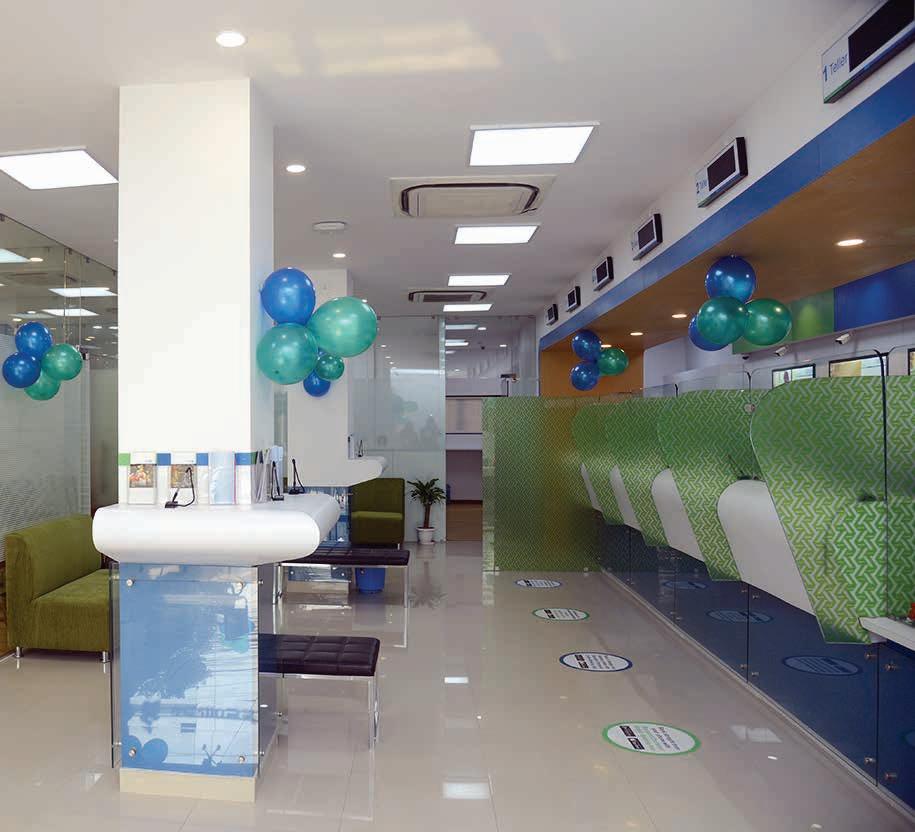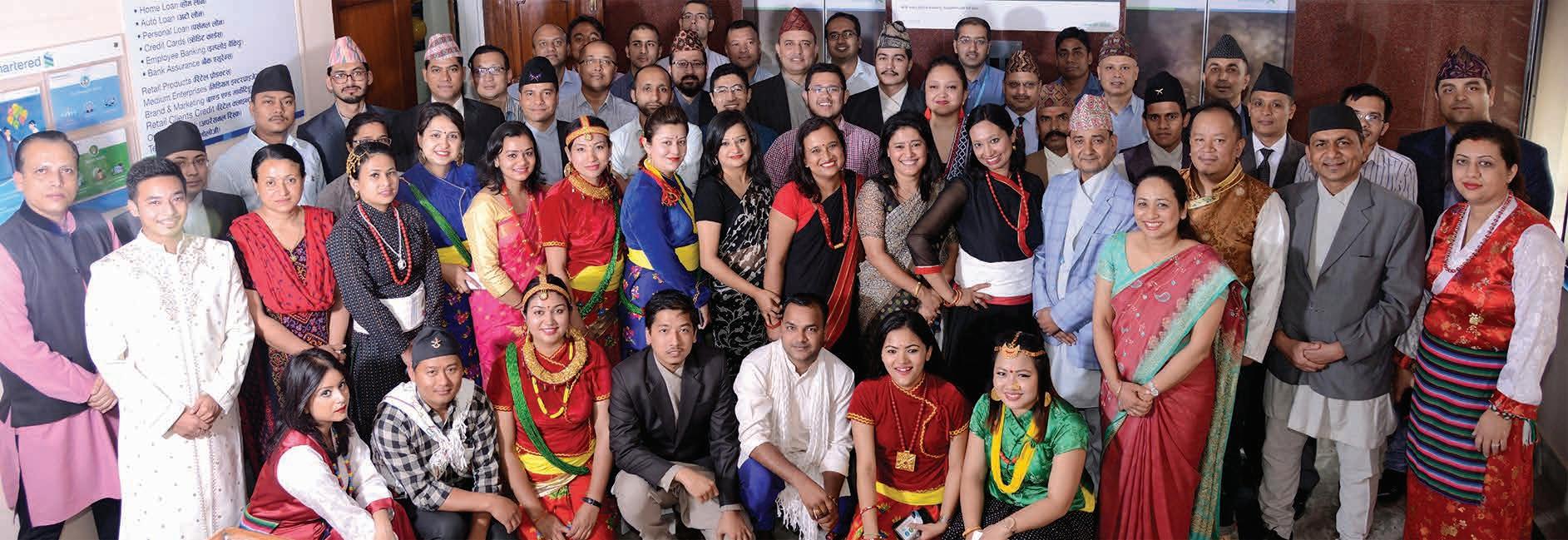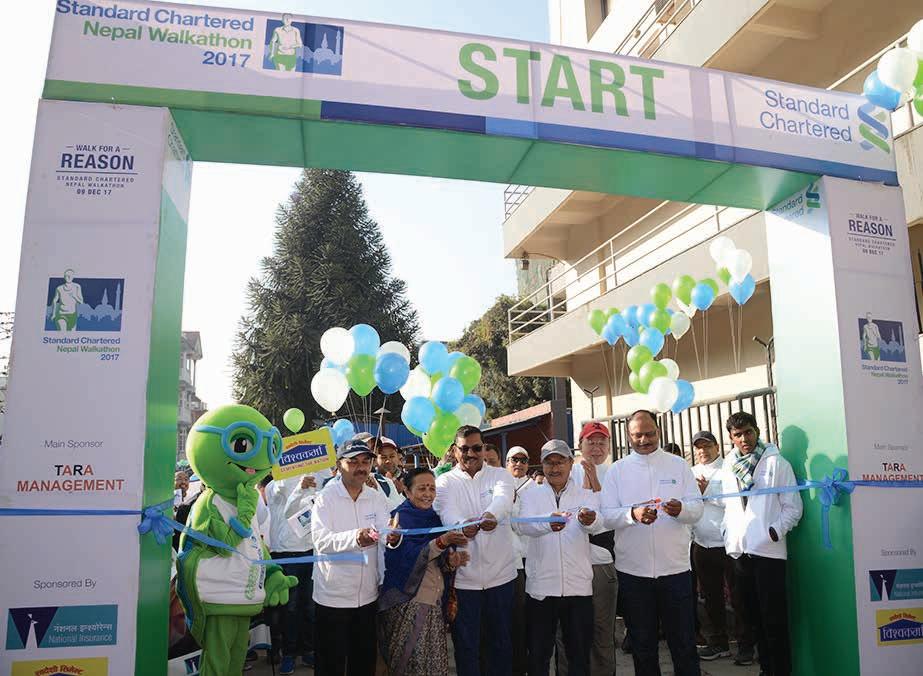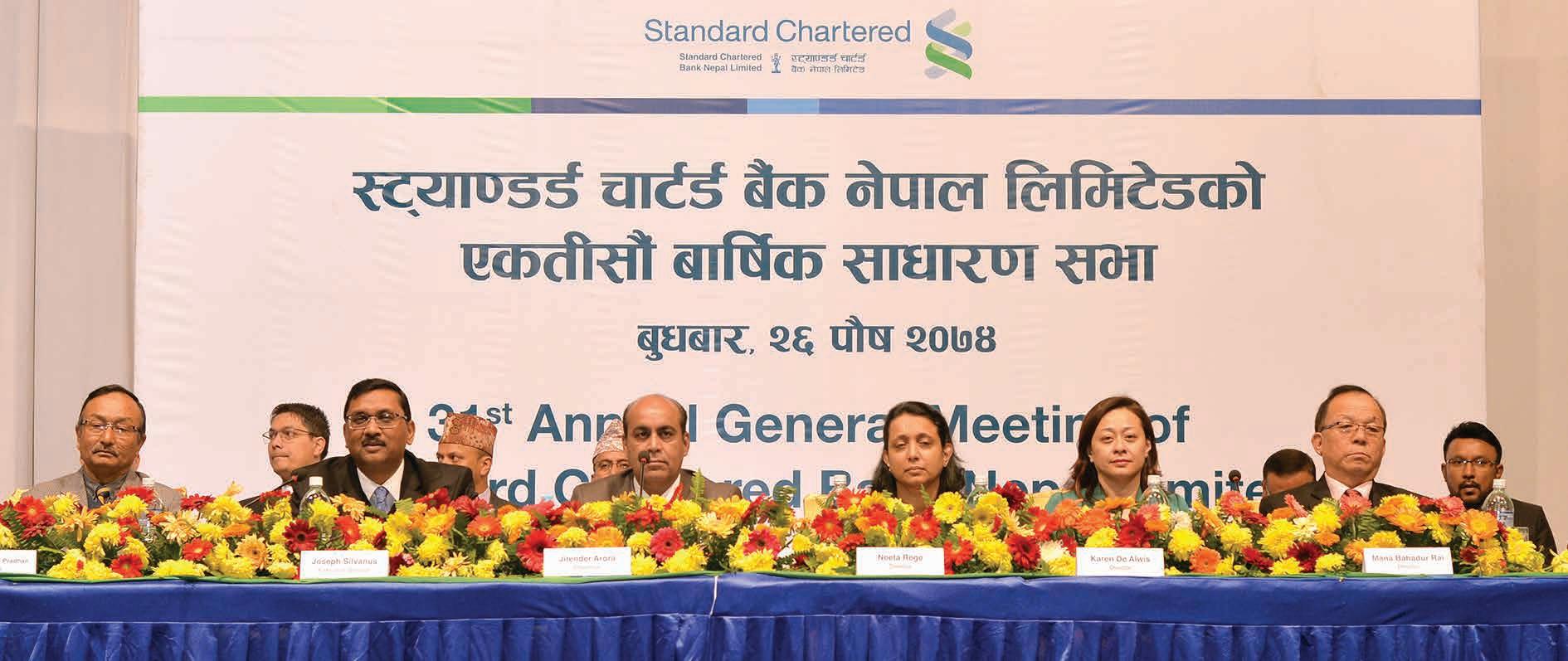
12 minute read
Chief Executive Officer's Report
CHIEF EXECUTIVE OFFICER'S REPORT The business is making steady progress against its strategic objectives.
I am pleased to report that the Bank has delivered a good performance in the financial year 2074-75. We have been able to deliver on our promises because of our consistent and focused strategy. There is an increase in the volume of risk assets by 16 percent to Rs. 44.56 billion compared to Rs. 38.43 billion last year. The Bank has been able to manage its credit portfolio better as a result of which the Non-performing credit to Total credit is 0.18 percent. The provisions made are adequate to cover all the potential credit losses as of the balance sheet date.
Advertisement
After transfer of Rs. 438 million to general reserve, Rs. 28 million to exchange fluctuation reserve, Rs. 346 million to regulatory reserves the net retained earnings as at 16 July, 2018 stood at Rs. 1,403 million. The Bank has proposed cash dividend of 17.50 percent out of this amount. This performance reflects a good momentum in the underlying businesses and disciplined management of risks and costs.
Representation
As at 16 July 2018, the Bank maintained fifteen points of representation which included twelve branches and three extension counters. In addition to this, services were also extended to our clients & customers through twenty-six ATMs located at different parts of the country.
Global Banking (GB) & Commercial Banking (CB)
Both GB and CB have achieved a well-balanced growth over the fiscal year. Assets, liabilities and contingents have all grown, which attests to rounded overall performance.
Our team has executed to the strategy to be the core bank and capitalized on growth opportunities. Further, we have also been able to diversify our revenue streams by introducing new products, variants and increased product penetration. New clients are also expected to provide impetus to our top line growth.
We take pride in standing by and for our clients during the interest rate volatilities observed over the last fiscal year. With a more narrowed range in the Interest Rate Corridor, we anticipate less volatility, as the market continues to mature.
We have been supporting the local banking community by providing comprehensive Correspondent Banking services. Straight2Bank (S2B), our world class digital platform provides payments, collections and trade services to our Corporate clients through various levels of online connectivity. We have integrated S2B with Nepal Clearing House Limited (NCHL) to provide seamless and straight through national payment processing via Inter-bank Payment System (IPS). In line with our digitization agenda, we have launched Virtual Account for Collection. These enhancements are expected to improve payment & collection experience for our clients and improve their working capital cycle and drive their productivity & efficiency. Our Financial Market business offers wide range of Online trading services which include FX Spot, Forward and Derivative
Blended Finance Conference was hosted by the Investment Board of Nepal (IBN) in April 2018 in partnership with Standard Chartered Bank and Confederation of Nepalese Industries
Products thus enabling counter parties to directly access global platform for Foreign Exchange Dealing & Trading.
As an international bank operating in Nepal, we continue to facilitate Nepal’s trade and commerce. Our network remains unparalleled. It is a matter of great pride for us in bringing the world to Nepal and vice versa.
Retail Banking
Retail Banking has had an encouraging start to the fiscal year, with increased business momentum.
Retail Banking continues to play a key role in maintaining overall liquidity for the Bank. Despite liquidity challenges and impact on underlying interest rates during the review period, Retail Banking has regained the business momentum.
Our Retail Banking strategic priorities continue to be revitalizing our liability base, boosting risk assets, reengineering our footprints, ramping up sales capabilities and taking up suitable digitization initiatives. Our efforts at Strategic Alliances/Partnerships, reengineering processes and capabilities continue to be key in improving our Client Experience and helping us become a Core Bank to our Clients. The business is making steady progress against its strategic objectives. We are stronger, leaner and becoming more efficient. We are taking significant actions to strengthen our long term growth. Retail Banking has undertaken several initiatives/actions during the review year to propel business to the next level. We continue to improve our end-to-end sales processes, resulting in significant efficiencies in the way we do our business. Driving cost efficiencies continues to remain key to prioritizing investments in Retail Banking e.g. the cost efficiencies achieved has enabled us to increase investment in strengthening our frontline capacity with additional Sales resources.
Our Employee Banking proposition is steadily working to drive our focused strategy of banking the ecosystem of our International Corporate, Commercial Banking and Business Banking (BB) clients. This has led to strong momentum in attracting new-to-bank clients.
The Bank has undertaken several digitization initiatives to overcome its footprint challenges. Online Banking capability has been enhanced to provide faster and better client experience for Personal Clients. Straight 2 Bank (S2B) is driving convenience for our Business Banking clients, with ease of banking from their offices. Digital initiatives like free and/or lower fees on ATM withdrawal within Nepal, SC Mobile app, The Good Life (TGL) app, complete SMS solution for debit and credit transactions, online purchases (eCommerce transactions) from the Bank issued Debit and Credit Cards, etc have helped to enhance client experience.
To deliver holistic financial solutions for helping small & medium sized entities in Nepal, Business Banking (erstwhile SME) has been offering a range of products. Over the period, we have been able to grow Business Banking book significantly and this continues to remain our focus area. The Bank has been contributing in the growth of priority sector in line with the Central Bank’s directive to lend in this sector; Business Banking is making significant contribution in this area.
Retail Banking continues to focus on introducing new products and digital solutions to cater to growing/ diversified need of our clients which is in line with the Bank’s brand promise - ‘Here for good’.
Client Experience
We believe in delivering high-quality client experience which will enable us to be Here for clients and help demonstrate how we are Here for good. Treating our Customer Fairly (TCF) is important in helping Bank deliver our Customer Charter and is consistent with our brand promise “Here for good”.
With an aim to drive superior service delivery, the Bank has established various client experience service standards viz Client Care Centre service level, Online Banking and ATM uptime service level, Complaint Resolution, Client Centric/ Treating Clients Fairly approach, Performance Measurement metrics and Standard Processing Turnaround Times, etc. The Bank leverages on the set service standards, complaint metrics, client interactions and surveys to understand client’s needs, trends, and drive improvement opportunities. Focused group discussions are held with the frontline and support staff to understand their pain points and actions are taken to address these issues to deliver service excellence. The Bank continues to focus on improving productivity by improving the processes, digitization initiatives and by standardizing the operating rhythm.
Relocation of the Bank's Lalitpur Branch to Norkhang Complex - Jawalakhel was completed on 21 Feburary 2018

Our global policies and procedures on complaint management help us to ensure that complaints are identified and resolved quickly in a fair manner. Root Cause Analysis (RCA) of the complaints are conducted to understand the actual cause for occurrence of the issue and actions are taken to prevent recurrence of similar complaints and issues.
Annual Loyalty Surveys are being conducted to gauge whether our clients are our true advocates on overall banking relationship across the Bank, Segments and Products through Net Promoter Score (NPS). Based on the feedback received, the Bank has been driving initiatives to enhance overall client experience.
The Bank believes that each staff owns and is accountable for client experience; keeping this in mind it continues to focus on trainings on products, systems, soft skills, and client experience for our staff to ensure we are heading on the right direction with our client focused strategy.
The table below shows the number of complaints received, and redressed during FYE 2017/18.
S. No. 1.
2.
3.
4.
Particulars
Cases pending at the beginning of the year Cases received during the year Cases redressed during the year Cases pending at the end of the year
No. of Complaints
5
949
952
2
Future Plans
Standard Chartered is uniquely placed to serve the growth aspiration of Nepal and work with all stakeholders. We are looking forward to Nepal being Country Rated as announced in the Budget Speech. This will be a key enabler to attract additional private sector funds in the longer tenure projects.
We continue to participate and meet the Priority Sector Lending requirements. We are open for business with developers that are willing to work with us. Advisory, Structuring, Financing and Arranging are our key strengths that we intend to leverage on.
We continue to educate and learn as we drive the digital agenda. The benefits of scalability, efficiencies and transparency will outweigh the inertia of adoption. We are a willing partner and we will continue our focus on this.
We will continue to diversify our revenue base and increase our product penetration with our existing client base as we look forward to a stable operating environment. We have made good progress in achieving excellence through our Digitisation agenda. In line with the changing digital landscape, we are further enhancing our digital platform to S2B NextGen which is a new & improved platform and will provide our clients an intuitive and simplified digital banking experience. Designed for mobility, S2BNextGen is equipped with modernised highly intuitive user interface which promotes greater usability and enhanced user experience. Enhancement of digital channels and offerings will continue to remain a priority for us.
Credit Environment
Nepal’s GDP growth rate has been estimated to be 5.9 percent (at basic prices) in FY 2074-75. GDP growth in FY 2073-74 rebounded to 7.4 percent as the economy was in the process of recovery from the 2072 earthquakes and the 2072-73 trade and supply disruptions. The drop on growth rate in the year 2074-75 was largely on the back of subdued agriculture outputs and flood in the Terai region which devastated the paddy output. While agriculture sector grew by 2.8 percent in 2074-75 against a growth of 5.2 percent in the earlier year, non-agriculture sector expanded by 7.1 percent during the year as against 8.5 percent in the previous year.
The manufacturing sector expanded during last fiscal year primarily due to improvement in power supply situation, decline in political protests as well as labour unrests and gradual pick up of the post-earthquake reconstruction works. The expansion of construction sector was significant among all sectors on the back of accelerated post-earthquake reconstruction activities along with other construction activities at sub-national levels; this also resulted in growth of the trading sector. In addition, the high consumption demand also boosted the wholesale and retail trading sector. Marked growth in the arrival of tourists increased the tourism activities.
Remittances continued to remain resilient, grew steadily and constituted above 25 percent of the country’s GDP. In the US dollar terms, the workers’ remittances increased by 10.2 percent to USD 7.22 billion during the 2074-75 The workers’ remittance is one of the major pillars of the economy and remains a key factor for the financial sector stability. The Balance of Payment (BoP) remained intermittently in deficits during the year due to large current account deficits; Balance of Payment however returned to a marginal surplus at the year end.
During FY 2074-75, country’s total exports increased by 15.5 percent and imports rose by a whopping 27.3 percent. Exports and imports had increased 9.9 percent and 30 percent respectively in the earlier year. Imports surged due to higher domestic demand compounded by higher oil prices. The increased reliance on imports and weak export competitiveness resulted in high import to export ratio which increased trade deficit rendering economic vulnerability. The widening trade deficit far exceeds the workers’ remittances and the external
sector stability remains vulnerable, particularly when oil prices are increasing and Nepalese Rupee is sharply depreciating against US Dollar.
The principal uncertainties impacting the overall credit environment in FY 2074-75 were socio-political uncertainty particularly in the first half, vulnerability in external sectors, tightening of liquidity / credit crunch, slower government’s development expenditure, etc. The rising imports and trade deficit outpacing the workers’ remittances, rights issues/FPOs of banks, higher government borrowing and low development expenditures, etc resulted in slower growth of deposits vis-à-vis credit growth during the year. The extended credit crunch in the second year in a row also impacted the business confidence despite a stable political outlook after the formation of a majority government in the beginning of second half.
Credit growth of commercial banks surpassed deposit collections in FY 2074-75 as well. The banks continue to have pressure to grow business in line with substantial capital growth, hence credit off-take picked up rapidly. Owing to constraints in local currency deposit growth, Nepal Rastra Bank had to allow banks to borrow up to 25 percent of their core capital in foreign currency with an aim to bring more liquidity in the system. However, banks are facing challenges in FX risk hedging on such foreign currency borrowings.
Inflation averaged at 4.2 percent in the last fiscal year, in line with 4.5 percent in the previous year. However, the rising import dependence, increasing oil prices and depreciation of Nepalese Rupee against US Dollar, are expected to put pressure on inflation in the current year.
The low inflation rates, comfortable foreign exchange reserves, low debt to GDP ratio, stable political outlook, etc. were some of the reassuring factors for the economy during the year. The banking sector remained resilient amid the extended lendable fund crunch and substantial rise in cost of deposits during the year.
The long term prognosis of the economy appears positive as we can expect political stability and a more conducive environment for economic activities. However, the country needs strong policies, sustained reforms, and adequate infrastructures to achieve the desired and stable economic growth.
We are committed to growing a strong and sustainable business. During FY 2074-75, the Bank remained successful in achieving disciplined growth in loans and advances and in effectively maintaining the credit quality of the loan portfolios notwithstanding a relatively weak credit environment and increased refinancing risk due to extended credit crunch. Our portfolios remained sound and resilient because of our risk culture, proactive portfolio measurement and adherence to the risk appetite.
We continue to manage risk with an objective to maximize the risk-adjusted returns while remaining within the Bank’s risk appetite. Embedding a healthy risk culture remains one of our key priorities. The fundamentals of our risk culture remain unchanged, particularly consistency of strategy and disciplined and focused approach, strong client relationship, rigors around portfolio quality, debate on risk-return dynamics, vigilance and timely actions, etc
Auditor
M/S SAR Associates, Chartered Accountants, were appointed as Statutory Auditors for FY 2017/18 by the 31st Annual General Meeting of the Bank held on 10 January 2018. As per the recommendation of the Audit Committee, this meeting will decide on the appointment of the auditor for next financial year
Proposed Dividend
The 376th Meeting of the Board of Directors of the Bank has proposed cash dividend to the shareholders of the Bank for the year ended 32 Ashadh 2075 at the rate of 17.50 percent.
Joseph Silvanus Director and CEO






